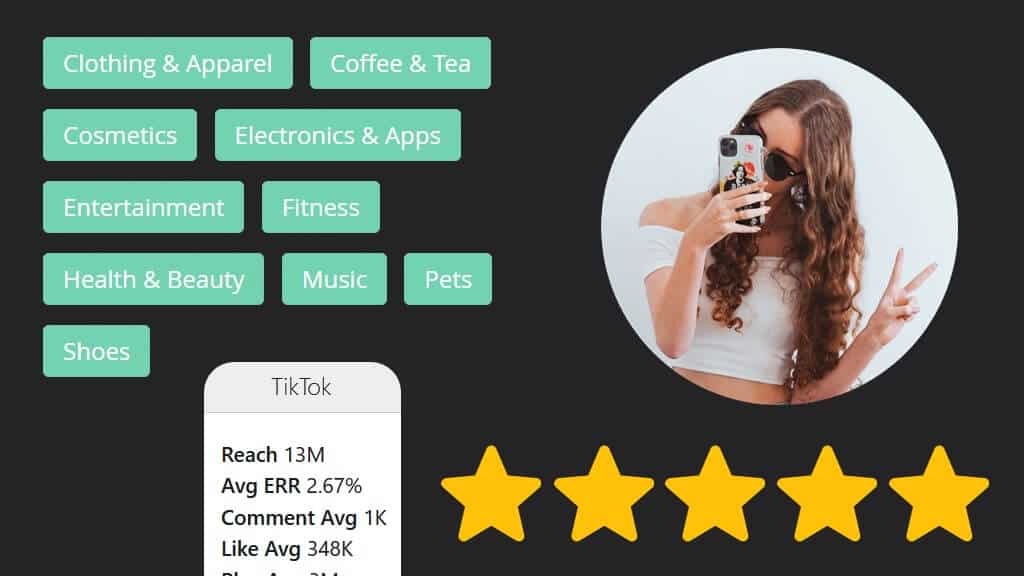When walking prospective brands through our platform during a demo, I am routinely asked some variation of the following question: “How do I know which influencers have legitimate followings?”
It’s a very fair question in the era of fake followers and manipulated data. Similar to determining how much to pay an influencer for their work, predicting the value an influencer will offer your brand requires a sound strategy combined with a little effort, but the results will likely make you happy.
Authenticity is Everything
In a recent survey conducted by Influencer Marketing Hub, 90% of professionals believe influencer marketing is an effective form of marketing. What separates influencer marketing from so many other methods is authenticity. A trusted influencer with a loyal following can promote your product or service in a natural way that doesn’t come off like a timeshare presentation or a rehearsed sales spiel.
That said, the value one influencer presents to your company can vary dramatically from another, so it’s important to know how to determine the best candidates before collaborating.
How do I check for fake followers?
Common examples that fall under the umbrella term “fake followers” include bots, purchased fake accounts (or even purchased real accounts), or passive followers that are organic but rarely interact within social networks beyond media consumption.
To date, no tool does a particularly great job of reporting on actual ‘fake’ with a sliding scale of type of follower while not having wildly incorrect false positives, mainly because followers can be categorized differently depending on who they are following. It’s not an easy task, which the networks themselves don’t even get right. Forget making apples to apples comparisons; determining fake followers isn’t even an apples to bananas comparison. It’s an apples to potting soil comparison, given how different they can be.
Trust me, we love automating processes and do it whenever we can! Feedback about the system from brand representatives, influencers, and our own Customer Success team helps to make our product stronger. When it comes to the strength of your campaign, taking a little extra time to manually review influencers before engaging pays off in a big way. Take a look at their profiles and see how many shares and likes their posts garner, in comparison to their comments. Look at the type of comments they receive. Are they substantive? Even this method of judgment should be used with discernment as some categories and networks (for example: Beauty content on Instagram) garner a lot of single word comments filled with emojis – and are from real followers. Longer form, thought provoking content generally garners more substantive comments.
How to calculate Instagram engagement rate
If you’re wondering how to calculate engagement rate on Instagram before you select influencers to work with, the manual process is relatively simple. You would begin by selecting a post that an Instagram influencer has made, which is a typical representation of their post activity in terms of likes and comments. To calculate engagement rate, divide the total number of likes and comments by the follower count of the influencer, then multiply that number by 100 to end up with a percentage:
Engagement Rate = (Likes + Comments) / Follower count x 100
If this seems arduous and you would rather use an engagement rate calculator – guess what? We do this behind the scenes for you and display it on each Instagram influencer’s Intellifluence profile page. Simply hover over the influencer’s Instagram link to see the metrics (I’ll go into further detail on this below).
So what is a “good” Instagram engagement rate? Similar to almost all components of influencer marketing, there are a lot of variables to consider. According to a study by Later, an average engagement rate for Instagram feed posts is 2.88%. You need to also consider the niche of the influencer, the amount of money and/or product they want in order to engage, as well as the quality of their follower base.
How to calculate YouTube engagement rate
When it comes to finding solid YouTubers to work with, you have options. You can use a YouTube engagement calculator, browse an Intellifluence YouTube influencer’s profile to find the data, or calculate the metric on your own. To calculate YouTube engagement rate on a per-video basis, add up the likes and comments and divide by the number of videos on the channel. Take that result then divide by the number of subscribers the channel has and multiply by 100 to get the YouTube engagement rate.
What is a “good” YouTube engagement rate? Somewhere between 1-3% is generally thought of as a solid engagement rate on YouTube, but that number can vary based on the subject of the channel and also the number of subscribers, in terms of perceived value for brands.
How to calculate TikTok engagement rate
Looking for ways to calculate engagement rate on TikTok? Similar to the other networks, we have an equation you can use:
Engagement Rate = (Likes + Comments + Shares) / Number of views x 100
Similar to Instagram and YouTube, we do the math for you when you visit the TikToker’s Intellifluence profile (and there are also TikTok engagement calculators out there if need be).
TikTok is one of the newer popular social networks and many brands continue to test the waters. We have also noticed that TikTok attracts higher engagement rates than other platforms on average, with a “good” TikTok engagement rate estimated to be around 4-18%. That said, the short-form video platform requires a special blend of creativity and brand self-awareness in order to be successful, especially as a brand trying to promote a product or service.
Our safeguards save you time and effort
That’s not to say you have to spend hours vetting and researching, as we have put safeguards in place to minimize any manipulation. First, we are a warm contact influencer network. This means each one of our influencers has joined our service on their own and are expecting to hear from you. The vast majority of our competitors are considered cold contact networks. Many will boast about their network size, but what you’re really paying for is access to a generic database full of creators. Some of these individuals are unaware of which services they “belong to” due to the impersonal nature of databases shared amongst cold contact influencer marketing services. Intellifluence influencers are fully aware they belong to Intellifluence, so your pitch will not come as a surprise to them.
Next, we verify social accounts for influencers whenever possible. Our preferred method is OAuth, which is a common type of access delegation. In short, it allows Intellifluence to verify that the person adding a social media account to their influencer profile has access to and controls that account. Lastly, engagement data (more on that below) combined with the aforementioned verification process provides peace of mind in terms of determining the legitimacy of each influencer.
So how do you evaluate the true influence of an influencer?
We have developed a proven three-part strategy that blends categorical expertise, data, and brand ratings to help you find and pitch influencers with confidence using Intellifluence.
1. Determine a categorical fit
You should begin the search by focusing within your niche. Some products and services are universal, so almost any qualified influencer could help, while others are more specialized and require topical expertise.
Several years ago, a brand was looking to promote a rather unique product – a spray solution and dispenser that would transform your toilet paper into a truly flushable wet wipe and avoid clogging your drains. This is an example of a product that requires a strong categorial fit (and an influencer with a sense of humor). Let’s face it, the product would stand out in an exquisitely curated, recipe-laden Instagram feed of a food and drink influencer – and not in a good way. If you pick an influencer with the wrong audience, you’re going to receive eyerolls instead of sales.
Whether you are creating a campaign, using the Discover tool to find influencers, or searching Influencer Offers, you have the ability to filter candidates by specialties in order to find influencers who are most qualified to promote your product or service to their audience. If I was tasked with setting up the toilet paper spray campaign, my categories of influencers to search would include Home and Garden, Bath and Body, Mommy, and Health.
From activism to writing, we currently feature 57 categories to choose from, ensuring you will be able to find a topical expert to collaborate with.
Once you have narrowed down your search within Discover or have received Marketplace applications from relevant influencers, it’s time to start reviewing their profiles to get to know them better.
2. Leverage the engagement data
We have designed influencer profiles to provide as much information as you need to make an educated decision, without overwhelming you with data. We recently added influencer engagement data to Instagram, TikTok and YouTube (certain networks restrict the sharing of engagement data and thus will not be available).

Within an influencer’s profile, simply hover over the respective network and you will see the following, if available:
Reach – The total number of followers for this social network.
Average ERR (Engagement Rate by Reach) – Think of this as an engagement rate calculator, or the average engagement rate the influencer receives based on their audience reach. For example, this saves you the time and effort in having to calculate Instagram engagement rate – we have done the work for you!
So, what’s a “good” engagement rate? That number varies dramatically across networks, but anything between 1 and 3.5% is generally viewed as an average-to-good engagement rate.
You might notice engagement rate trends downwards as audience size increases. Peer influencers (sometimes referred to as micro influencers) with smaller followings may offer a higher engagement rate than aspirational influencers (celebrities, public figures, etc.), which presents a balancing act for brands. Resist the urge to fixate on follower count as the be-all and end-all, as a solid categorical fit with a strong engagement rate can often outperform another influencer with a massive following, but isn’t in your niche.
Comment Average – The average amount of comments the influencer’s posts/videos receive.
Like Average – The average amount of likes the influencer’s posts/videos receive.
Play Average – The average number of plays the influencer’s videos receive (if applicable).
Share Average – The average number of shares the influencer’s posts/videos receive.
In case you are wondering, yes, engagement data can be manipulated just like follower count. So how can you be confident in an influencer’s legitimacy? That leads us to the last part of the vetting strategy:
3. Review the Influencer’s rating
If an influencer has completed transactions within Intellifluence, they will have a star rating on their profile, along with the total number of transactions they have successfully completed.

This is a valuable metric to consider because it’s comprised solely of ratings from brands they have worked with. If an influencer has completed 31 transactions and enjoys a 5-star rating, that’s a good sign they are also going to perform for you. It’s a metric that cannot be manipulated by the influencer, so it should instill trust.
Summary
If you determine the influencer you are reviewing is a strong categorical fit, has a favorable engagement rate and enjoys a solid rating, you can pitch with confidence.
So what happens if you run into an issue? We’re here for you.
Per our Terms of Service, The Intellifluence influencer network is limited to those who have grown their audience organically and we reserve the right to terminate Influencer accounts that misrepresent their audience size or engagement.
If you suspect there are discrepancies with an influencer’s following, you have the ability to report an issue via the influencer’s profile or if you are involved in a transaction with the influencer, you can flag it to let us know.
As a quick recap:
- Services that promise giving you the ability to perform a fake follower check aren’t as effective as personally vetting
- Intellifluence utilizes access delegation to minimize any illegitimate influencer profiles
- You don’t have to spend time using an external engagement rate calculator – we have the data built in for the most popular social media platforms
- Determining a categorical fit, leveraging our engagement rate data and reviewing an influencer’s rating can help you get the most out of your campaigns

Andrew is the Head of Client Services for Intellifluence and has a background in communications. He is committed to helping brands get the most out of their campaigns and is the co-host of the Influencer Spotlight series.






